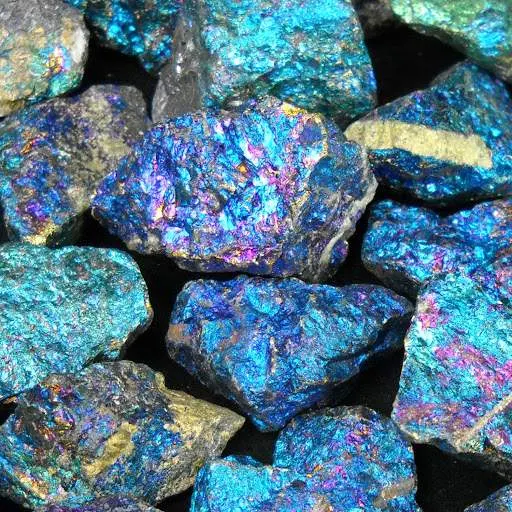Peacock Rocks: Iridescent Bornite and Chalcopyrite
Peacock Rock, also known as Peacock Ore, is a stunning mineral prized for its vibrant, iridescent colors that resemble a peacock's plumage. It's not actually a single rock type, but rather a nickname for two minerals: bornite and chalcopyrite, which exhibit this remarkable iridescence when tarnished.
Bornite (Peacock Ore)
This is the most common meaning of "Peacock Rock." Bornite is a mineral with a chemical composition of Cu5FeS4 and belongs to the sulfide group. Its most striking feature is its iridescence, displaying vibrant blue, purple, green, and gold hues due to tarnish on its surface. This iridescence is why it earned the nickname "Peacock Ore" or "Peacock Rock."
Formation: Found in hydrothermal veins and contact metamorphic rocks where copper deposits exist. Bornite is found in hydrothermal veins and contact metamorphic rocks.
Association: Chalcopyrite, pyrite, other copper and iron sulfides, garnet, calcite, wollastonite, quartz.
Uses: Primarily used as an ore for its copper content (up to 63%). Some specimens with exceptional iridescence are valued as collector's stones and occasionally used in jewelry or decorative objects.
Bornite is an important ore of copper and is found in various locations worldwide, including the United States, Canada, Mexico, Chile, and Peru.
Iridescent Chalcopyrite
Chalcopyrite with Tarnish. Similar to bornite, chalcopyrite, another copper sulfide mineral, can also tarnish and develop an iridescent sheen resembling a peacock's feathers. This tarnish can be a combination of blue, purple, green, and gold, just like bornite. Therefore, some people also call tarnished chalcopyrite "Peacock Rock."
Mineral composition: Chalcopyrite, another sulfide mineral with the chemical formula CuFeS2.
Formation: Chalcopyrite is a more common mineral than bornite and is found in various geological settings, including igneous and sedimentary rocks.
Uses: Primarily used as an ore for its copper content (up to 35%). Less frequently used for ornamental purposes due to its weaker iridescence.

The iridescent colors of iridescent chalcopyrite are caused by a phenomenon called thin-film interference. When light hits the surface of the mineral, it is reflected by both the top and bottom of the thin film of tarnish that coats the mineral. The two reflected waves interfere with each other, and the resulting interference pattern produces the rainbow of colors that we see.
Properties iridescent chalcopyrite
Category: Sulfide
Color: Copper-red or reddish-bronze on fresh surface, brown-black with bluish-purple when tarnished
Luster: Metallic when fresh, tarnishes too iridescent
Hardness: 3 - 3.25
Streak: Grayish-black
Tenacity: Brittle
Crystal Habit: Granular, massive disseminated grains, rare octahedrons
Location: Mainly Connecticut, Montana, Arizona, Peru, Mexico, Morocco
 |
| Peacock ore: Iridescent Bornite and Chalcopyrite |
Iridescence: The Peacock Effect
The dazzling iridescence seen in both minerals is caused by surface oxidation, which forms a thin film of oxides or sulfates. This layer interacts with light through interference and diffraction, producing the rainbow-like colors. Key factors influencing the iridescence include:
- Thickness of the Oxide Layer: Thinner layers produce blue and violet hues, while thicker layers result in green, yellow, and red colors.
- Exposure to Air and Moisture: Enhances the oxidation process.
- Surface Texture: Affects the scattering of light and intensity of colors.
Uses and Applications of Peacock Rock
Industrial uses:
Copper extraction: The primary use of peacock rock is as an ore for copper extraction. It contains a significant amount of copper, typically around 63.3%, making it a valuable source for this essential metal. The copper extracted from peacock rock is used in various applications, including:
Electrical wiring: Copper is an excellent conductor of electricity, making it ideal for electrical wires and cables.
Plumbing: Copper pipes and fittings are known for their durability and resistance to corrosion, making them popular choices for plumbing systems.
Construction: Copper is used in various construction materials, such as roofing and flashing, due to its durability and weather resistance.
Industrial applications: Copper is used in a wide range of industrial applications, including heat exchangers, bearings, and machinery components.
Jewelry and decorative items: Peacock rock with exceptional iridescence and color patterns is sometimes used in jewelry and decorative items. It can be polished or cut into cabochons and used in rings, pendants, and other pieces. However, due to its relative softness and brittleness, it is not as commonly used in jewelry as other gemstones.
 |
Peacock ore," or bornite, displaying iridescent blue, purple, and green colors due to tarnish on a metallic copper-red base. |
Metaphysical and spiritual uses:
Crystal healing: Some people believe that peacock rock has metaphysical properties and can be used for healing and spiritual growth. It is associated with the heart chakra and is said to promote love, compassion, and emotional well-being. It is also believed to help with spiritual connection and enlightenment. However, it is important to remember that there is no scientific evidence to support these claims.
 |
| Peacock Ore (Bornite) with Chalcopyrite showcasing its iridescent surface and metallic luster. |
Collecting:
Mineral specimens: Peacock rock with beautiful iridescent colors and patterns is prized by mineral collectors. High-quality specimens can be quite valuable.
Peacock rocks, with their stunning iridescence and rich geological history, are a testament to the beauty and complexity of Earth’s mineralogical processes. Whether appreciated for their scientific importance or aesthetic value, they remain enduring symbols of the interplay between nature and art.


%20(1).webp)






